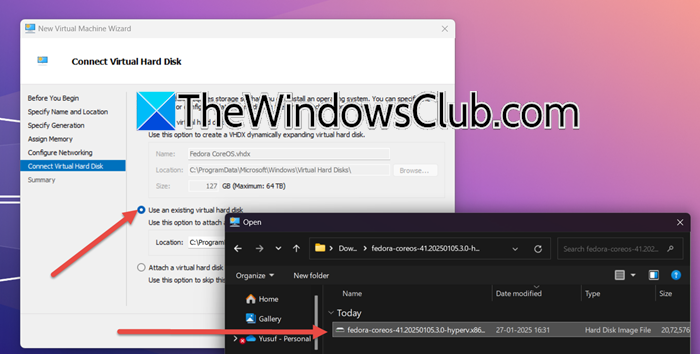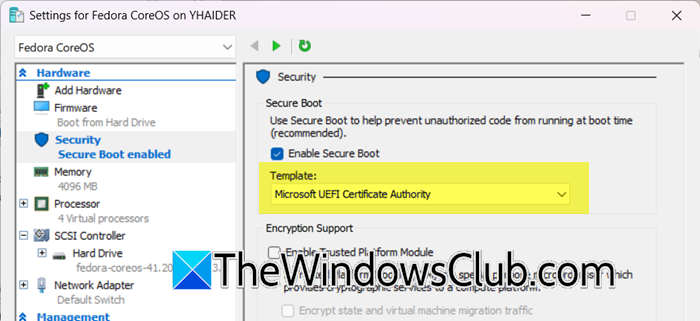In this guide, we are going to talk about an easy method to install Fedora CoreOS on Hyper-V. Fedora CoreOS is a container-focused operating system (OS) created for running containerized workloads securely and at scale. So, if your organization requires a centralized system, you can install Fedora CoreOS on your Windows machine, even the server. Essentially, Fedora CoreOS is great for developers and IT professionals who need a reliable and secure environment for running containers at scale.
What is Fedora CoreOS for?
Fedora CoreOS is a specialized operating system designed to run containerized applications. It’s lightweight, meaning it doesn’t have unnecessary components, and focuses on security and automatic updates to keep everything up-to-date without manual intervention.
Install Fedora CoreOS on Hyper-V
If you want to install Fedora CoreOS on Hyper-V, follow the steps mentioned below.
- Get prerequisite software
- Create your virtual machine
- Start Fedora CoreOS
Let us talk about them in detail.
1] Get prerequisite software

First of all, you need to make sure that you have all the tools required for the installation. So, we would like you to go to fedoraproject.org, scroll down to reach Bare Metal & Virtualized section, and then click on the download button next to FedoraOS Hyper-V. This will start downloading a ZIP file.
Next up, you need to enable Hyper-V, since it is Microsoft’s proprietary software, we don’t have to download anything. To do so, follow the steps mentioned below.
- Open the Control Panel.
- Go to Programs > Programs and Features.
- Click on the Turn Windows feature on or off.
- Tick the Hyper-V option and make sure that both the options below it are checked as well.
- Finally, click on Ok.
Once you have installed both tools, let us go to the creation of the virtual machine. If you are using Windows Home edition, check our guide on how to install Hyper-V on Windows 11 Home.
2] Create your virtual machine

Now that we have the Hyper-V installed on our system and the Fedora CoreOS file download, let us go ahead and create a virtual machine. But before that, we should unzip the ZIP file that we downloaded earlier. To do so, go to the Download folder, right-click on the ZIP file, and select Extract All; make sure to set the correct location, and once done, you will have your Hyper-V Hard disk that we need to attach.
Additionally, make sure to create a Virtual Switch in Hyper-V, if you don’t want to go with the default option.
To create the virtual machine, you should follow the steps mentioned below.
- Open the Hyper-V Manager by searching it out of the Start Menu.
- Click on Action > New > Virtual Machine.
- Click on Next, give your virtual machine a name, and click on Next.
- Set Generation 2 and click on Next.
- Select a memory and click on Next.
- Now, select the virtual switch that you have created or set the default one and click on Next.
- Select Use an existing virtual hard disk and click on Browse.
- Go to the location where you have extracted Fedora, open the folder, and choose the VHDX file of Fedora. Click on Next.
- Check the Summary and click on Next.
After creating the machine, don’t just start it as we need to configure the virtual machine.

To successfully boot Fedora CoreOS on a Generation 2 virtual machine, you need to update the Secure Boot template to the Microsoft UEFI Certificate Authority. This adjustment can be made in the Security tab within the virtual machine’s Settings dialog. Just right-click on the VM and select Settings, you will get to see the Security tab, just go there and Secure Boot template to the Microsoft UEFI Certificate Authority.
Read: How to install macOS in Hyper-V on Windows 11
3] Start Fedora CoreOS
Finally, you can just right-click on the virtual machine and select Start. Then, again, right-click and select Connect. This way, you can easily start the machine and connect to it. The system automatically creates a privileged user named “core” by default. However, this user does not come with a pre-configured password or SSH key. If you want to use the “core” user, you’ll need to provide an Ignition config that includes a password and/or SSH keys. Additionally, you can use Ignition configs to create new users with their own credentials.
Alternatively, you can use the Afterburn support from coreos.github.io and provide an SSH key via your color provider.
To know more about the user in Fedora, go to our docs.fedora.com.
Hopefully, with the help of this guide, you can create and start using Fedora CoreOS.
How to run Fedora on Hyper V?
If you want to run Fedora Workstation, you will have to download the ISO file, create the machine, and then install Fedora. However, if you are going for Fedora CentOS, download and add the CentOS virtual hard disk. These guides will show you how to install Fedora on VMware Workstation and Oracle VM VirtualBox – and have provided the guide to create an provision Fedora CentOS in Microsoft’s Hyper-V in this post.